
CORMÒNS
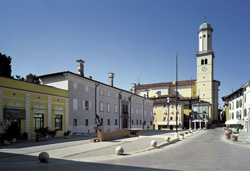 A column of smoke arising from the top of the mount Quarin signalled danger.
From fortress to fortress it reached the Carnia, the boundary of the Roman
Empire, which was threatened by barbarian invasions.
A column of smoke arising from the top of the mount Quarin signalled danger.
From fortress to fortress it reached the Carnia, the boundary of the Roman
Empire, which was threatened by barbarian invasions. Of that ancient fortress in Cormòns, only a massive breached tower and an irregular ring of stones belonging to the ancient walls remain today. Nonetheless, the expansive view is always marvellous from these remains.
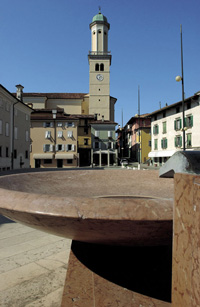 From the top of the Alps the view descends to the so-called “Soglia di Gorizia”,
i.e. the lowest passage of the Alps from which the barbarians coming from
the Far East countries entered Italy during the dark ages. The gentle slopes
of the Collio patched with vineyards and cherry trees lie all around the area.
Southwards, the plain is crossed by the Isonzo River which flows into the
Adriatic Sea, glittering in the sunshine.
From the top of the Alps the view descends to the so-called “Soglia di Gorizia”,
i.e. the lowest passage of the Alps from which the barbarians coming from
the Far East countries entered Italy during the dark ages. The gentle slopes
of the Collio patched with vineyards and cherry trees lie all around the area.
Southwards, the plain is crossed by the Isonzo River which flows into the
Adriatic Sea, glittering in the sunshine. 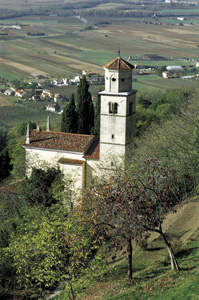 From the top of mount Quarin, the panoramic view up to nearby Slovenia lets
us understand why Cormòns is pleased to define itself as “the heart”
of the Collio. The town not only represents a geographic centre but also an
economic point of reference. As a matter of fact, it has been the main centre
of this enchanting hilly area next to Gorizia for ages. Today it is well reputed
for its wine, excellent restaurants, elegant hotels and comfortable agriturismo
(farms serving typical regional dishes.)
From the top of mount Quarin, the panoramic view up to nearby Slovenia lets
us understand why Cormòns is pleased to define itself as “the heart”
of the Collio. The town not only represents a geographic centre but also an
economic point of reference. As a matter of fact, it has been the main centre
of this enchanting hilly area next to Gorizia for ages. Today it is well reputed
for its wine, excellent restaurants, elegant hotels and comfortable agriturismo
(farms serving typical regional dishes.) The ancient origin of its name probably derives from the Celtic word Carmona, (the land of weasels). In the VIII century, it was seat of the Aquileian patriarch and prior to that it was already famous for its wine and fruit production.
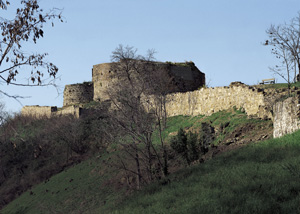 In the Middle Ages, it was a trade centre. Between the 1600s and the 1700s
it was embellished with churches and palaces. Today, Cormòns is a quiet
town in Hapsburg style featuring private and public buildings with nice facades,
churches with onion-like domes and a theatre in neoclassic style.
In the Middle Ages, it was a trade centre. Between the 1600s and the 1700s
it was embellished with churches and palaces. Today, Cormòns is a quiet
town in Hapsburg style featuring private and public buildings with nice facades,
churches with onion-like domes and a theatre in neoclassic style. The most ancient part of Cormòns is the medieval centa of Lombard origins, i.e. a maze of narrow alleys lined with brightly painted houses, around which lies the historic centre, characterized by harmonious 17th- and 18th-century buildings. Like for instance, the Cathedral of Sant’Adalberto, an imposing 18th-century building, the neoclassic palazzo Locatelli (now seat of the Town Hall) whose harmonious façade overlooks Piazza XXIV Maggio, the “lounge” of the town. As a matter of fact, the Cormòns inhabitants enjoy meeting in this square, which hosted the market during the Middle Ages. Today, thanks to a renowned wine cellar and to elegant bars, this square has been deputed for the tajut, rite (the very popular aperitif of the Friuli region consisting of white wine “flavoured” with chats). The Piazza XXIV Maggio has a magical atmosphere on the summer evenings, with people comfortably seated at the tables of the bars, listening to music and admiring the starry sky into the small hours.
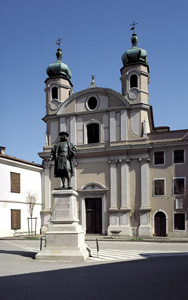 Strolling around Cormòns, we discover small architectural treasures,
such as the late medieval tower belonging to the ancient wall ring, which
is today part of a very well kept vineyard at via Cancelleria Vecchia, the
monumental gate surmounted by a triple lancet window of the 18th-century building
Devetag-Del Mestre at n. 70 via Matteotti, the church of St. Leopold located
in the south east area featuring precious stalls carved in wood, the 18th-century
sanctuary of the Rosa Mistica, designed by the Lombard architect Carlo Corbellini.
Just in front of the sanctuary, in the centre of Piazza Libertà lies
the bronze statue of the Hapsburg Emperor Massimiliano I, an unusual work
of art which stands imposingly on a high marble pedestal. We ask ourselves
whether it represents nostalgia or retaliation . It is a witness of the past
and of a century-long presence of the Austro Hungarian Empire.
Strolling around Cormòns, we discover small architectural treasures,
such as the late medieval tower belonging to the ancient wall ring, which
is today part of a very well kept vineyard at via Cancelleria Vecchia, the
monumental gate surmounted by a triple lancet window of the 18th-century building
Devetag-Del Mestre at n. 70 via Matteotti, the church of St. Leopold located
in the south east area featuring precious stalls carved in wood, the 18th-century
sanctuary of the Rosa Mistica, designed by the Lombard architect Carlo Corbellini.
Just in front of the sanctuary, in the centre of Piazza Libertà lies
the bronze statue of the Hapsburg Emperor Massimiliano I, an unusual work
of art which stands imposingly on a high marble pedestal. We ask ourselves
whether it represents nostalgia or retaliation . It is a witness of the past
and of a century-long presence of the Austro Hungarian Empire. In 1903, the statue was set in the square formerly named piazza Cumano, to commemorate the 4th anniversary of the annexation to the Great Empire. By means of this statue the Cormòns inhabitants paid tribute to Emperor Massimiliano I, who in 1518 had granted to Cormòns the status of ‘town’ and tax exemption for six years. These concessions were possible thanks to the remarkable wines destined to the Emperor’s table.
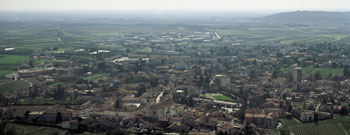 The statue was removed at the beginning of World War I and relocated in the
square in 1981 upon wish of the Cormòns inhabitants, who are very attached
to memories and traditions. A spectacular historic representation in honour
of the Emperor and of the strong link with the past is held in Cormòns
on the first Sunday of September during which duels on horses are performed,
more than five hundred ladies and knights, fencers and Lansquenets parade
along the main streets. Added to this, another awaited event takes place on
the second Sunday of September: the feast of the grapes. The rite of the grape
harvest is one of the older events in Italy and has been celebrated for over
seventy five years. On this occasion the so-called “wine for peace” is shipped
to major head of states around the world in a sign of peace and brotherhood.
This special wine is fermented from the harvest of over four hundred grapes
coming from the ‘Vineyard of the World’ (a blend of vines originating in the
five continents, which is grown in the area, thanks to the enterprise of the
Producers’ Association of Cormòns).
The statue was removed at the beginning of World War I and relocated in the
square in 1981 upon wish of the Cormòns inhabitants, who are very attached
to memories and traditions. A spectacular historic representation in honour
of the Emperor and of the strong link with the past is held in Cormòns
on the first Sunday of September during which duels on horses are performed,
more than five hundred ladies and knights, fencers and Lansquenets parade
along the main streets. Added to this, another awaited event takes place on
the second Sunday of September: the feast of the grapes. The rite of the grape
harvest is one of the older events in Italy and has been celebrated for over
seventy five years. On this occasion the so-called “wine for peace” is shipped
to major head of states around the world in a sign of peace and brotherhood.
This special wine is fermented from the harvest of over four hundred grapes
coming from the ‘Vineyard of the World’ (a blend of vines originating in the
five continents, which is grown in the area, thanks to the enterprise of the
Producers’ Association of Cormòns). 